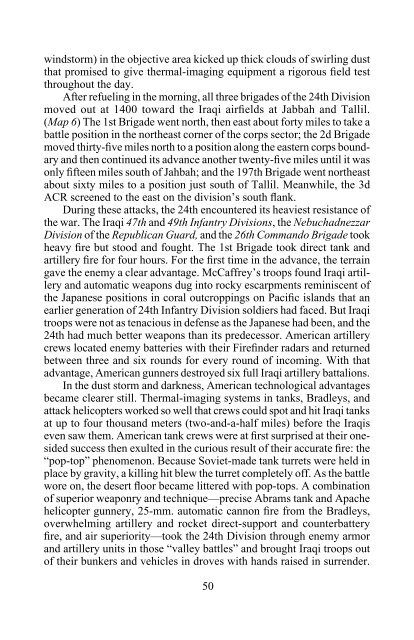You also want an ePaper? Increase the reach of your titles
YUMPU automatically turns print PDFs into web optimized ePapers that Google loves.
windstorm) in the objective area kicked up thick clouds of swirling dustthat promised to give thermal-imaging equipment a rigorous field testthroughout the day.After refueling in the morning, all three brigades of the 24th Divisionmoved out at 1400 toward the Iraqi airfields at Jabbah and Tallil.(Map 6) The 1st Brigade went north, then east about forty miles to take abattle position in the northeast corner of the corps sector; the 2d Brigademoved thirty-five miles north to a position along the eastern corps boundaryand then continued its advance another twenty-five miles until it wasonly fifteen miles south of Jahbah; and the 197th Brigade went northeastabout sixty miles to a position just south of Tallil. Meanwhile, the 3dACR screened to the east on the division’s south flank.During these attacks, the 24th encountered its heaviest resistance ofthe war. The Iraqi 47th and 49th Infantry Divisions, the NebuchadnezzarDivision of the Republican Guard, and the 26th Commando Brigade tookheavy fire but stood and fought. The 1st Brigade took direct tank andartillery fire for four hours. For the first time in the advance, the terraingave the enemy a clear advantage. McCaffrey’s troops found Iraqi artilleryand automatic weapons dug into rocky escarpments reminiscent ofthe Japanese positions in coral outcroppings on Pacific islands that anearlier generation of 24th Infantry Division soldiers had faced. But Iraqitroops were not as tenacious in defense as the Japanese had been, and the24th had much better weapons than its predecessor. American artillerycrews located enemy batteries with their Firefinder radars and returnedbetween three and six rounds for every round of incoming. With thatadvantage, American gunners destroyed six full Iraqi artillery battalions.In the dust storm and darkness, American technological advantagesbecame clearer still. Thermal-imaging systems in tanks, Bradleys, andattack helicopters worked so well that crews could spot and hit Iraqi tanksat up to four thousand meters (two-and-a-half miles) before the Iraqiseven saw them. American tank crews were at first surprised at their onesidedsuccess then exulted in the curious result of their accurate fire: the“pop-top” phenomenon. Because Soviet-made tank turrets were held inplace by gravity, a killing hit blew the turret completely off. As the battlewore on, the desert floor became littered with pop-tops. A combinationof superior weaponry and technique—precise Abrams tank and Apachehelicopter gunnery, 25-mm. automatic cannon fire from the Bradleys,overwhelming artillery and rocket direct-support and counterbatteryfire, and air superiority—took the 24th Division through enemy armorand artillery units in those “valley battles” and brought Iraqi troops outof their bunkers and vehicles in droves with hands raised in surrender.50












